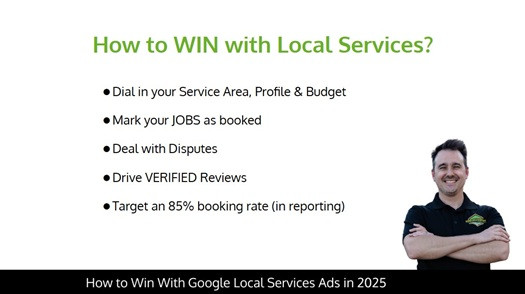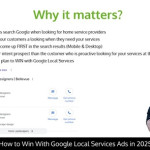2025 Google Local Services Ads: L&HCM’s Tips for Contractor Success

When contractors effectively leverage Google Local Services Ads, they can achieve measurable ROI improvements through the strategic implementation of five core optimization principles. First, maintain a verified Google Business Profile status with updated licensing and insurance documentation. Second, prioritize high-quality customer reviews through systematic follow-up processes that enhance ranking algorithms. Third, optimize ad content with professional project photos and detailed service descriptions that improve conversion rates. Fourth, implement responsive customer engagement protocols within platform requirements to maximize lead quality. Fifth, conduct regular performance assessments using revenue tracking metrics to identify opportunities for optimization and adjust bidding strategies for sustained growth.
Google Local Services Ads require contractors to master five critical components that directly impact campaign performance and profitability. Platform requirements establish the foundation through mandatory Google Business Profile verification and background checks, while ranking optimization focuses on review quality metrics and responsiveness rates that determine ad visibility. Successful contractors implement targeted lead generation strategies, establish ROI measurement systems to track revenue conversion, and navigate the technical application setup process to achieve Google Guaranteed status.
Platform Requirements Overview
Before contractors can leverage Google Local Services Ads' pay-per-lead model, they must satisfy several mandatory platform eligibility criteria that directly impact ad approval and revenue potential. Google requires verified Business Profile integration, current licensing documentation, and thorough insurance verification. Background checks for owners and employees are mandatory to obtain the Google Guaranteed badge, which has been shown to increase conversion rates by 23%. Ad content guidelines mandate accurate business hours, service area specifications, and high-resolution project photos. State-specific licensing requirements vary considerably, affecting approval timelines. Non-compliance with these technical requirements results in immediate ad suspension, which eliminates lead generation capabilities and reduces market visibility compared to competitors.
Ranking Factor Optimization
Although contractors meet platform requirements, their ad visibility depends on Google's algorithmic ranking system that prioritizes review quality, response speed, and profile completeness. Effective review strategies have a direct impact on ranking positions, with both the quantity and star ratings influencing algorithmic preferences. Contractors must maintain an average rating of 4.0 or higher while actively soliciting reviews from satisfied customers. Response time metrics critically affect visibility—Google tracks inquiry response speed and penalizes delayed responses. Optimized ad content requires high-quality project photos, detailed service descriptions, and current business hours. Profile completeness signals authority to Google's algorithm, while consistent engagement with customer inquiries demonstrates reliability, ultimately improving lead generation ROI.
Lead Generation Strategies

When contractors implement systematic lead generation through Local Services Ads, they're fundamentally creating a direct pipeline from high-intent searchers to qualified prospects who've already demonstrated purchase readiness. Strategic lead generation requires immediate response protocols—leads contacted within five minutes convert 21x more frequently than those reached after thirty minutes. Customer engagement optimization involves crafting compelling ad descriptions that highlight specialized services, maintaining a 90 %+ response rate, and leveraging the Google Guaranteed badge for trust and conversion. Contractors maximizing ROI focus on lead quality metrics rather than volume, tracking cost-per-acquisition against lifetime customer value to guarantee sustainable profit margins from their advertising investment.
ROI Measurement Tactics
Since Local Services Ads operate on a pay-per-lead model rather than the traditional pay-per-click model, contractors must implement precise tracking methodologies that directly connect ad spend to revenue outcomes. Effective roi tracking requires documenting each lead's progression from initial contact through project completion, establishing clear attribution between Google-generated leads and closed sales. Conversion analysis should examine lead quality metrics, including response times, booking rates, and average project values. Contractors must calculate cost-per-acquisition against lifetime customer value, tracking seasonal performance variations and service-specific conversion rates. This systematic approach enables data-driven budget allocation decisions and identifies high-performing lead sources within the platform.
Application Setup Process
Contractors entering Google Local Services Ads must navigate a multi-step verification process that directly impacts time-to-market and revenue generation potential. The application checklist requires thorough documentation, including licensing credentials, insurance certificates, and employee background checks, to secure Google's guaranteed badge. This verification process typically spans 5-7 business days, though complex licensing scenarios can extend timelines considerably. Incomplete submissions delay market entry and revenue opportunities. Competent contractors prepare documentation in advance, ensuring all licensing details align with state requirements. Background checks for owners and key employees represent non-negotiable prerequisites that can't be expedited, making early preparation essential for competitive advantage.
Final Tips From L&HCM to Master Google LSAs

Three critical factors separate successful landscape contractors from those struggling with Google Local Services Ads: systematic review management, strategic bid optimization, and data-driven performance tracking. Top performers implement automated review solicitation systems, achieving 4.5-star ratings or higher with a minimum of 50 reviews. They adjust bids based on lead conversion rates rather than volume alone, targeting 3- 5x ROI benchmarks. Successful contractors track cost-per-acquisition alongside lifetime customer value, enabling precise budget allocation across local services campaigns. These advertising strategies require monthly performance audits, competitor analysis, and continuous profile optimization. Contractors following this framework consistently outperform competitors by 40-60% in lead quality metrics.




